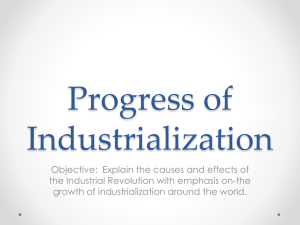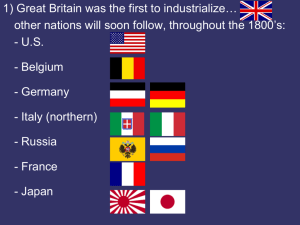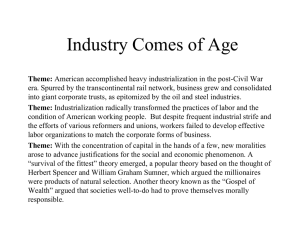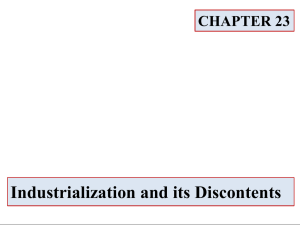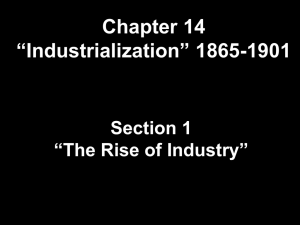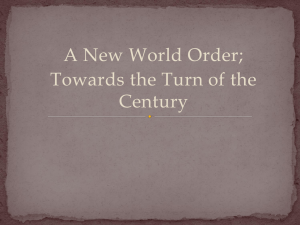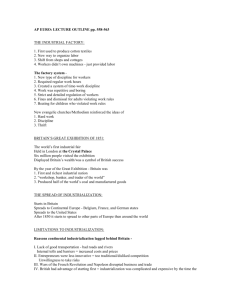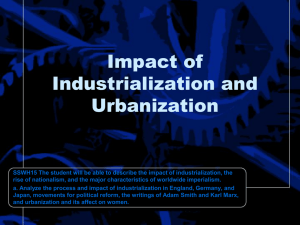The Industrial Revolution, 1760-1850
advertisement
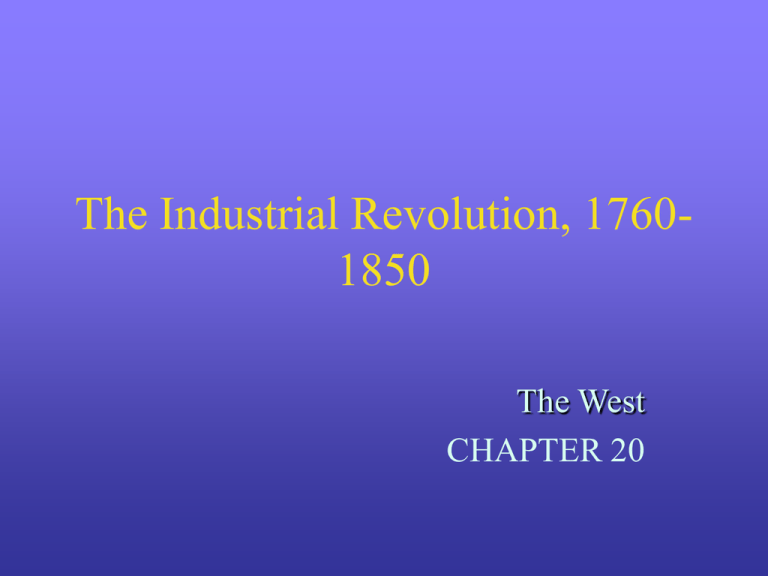
The Industrial Revolution, 17601850 The West CHAPTER 20 New Industrial Technology • Dramatic increase in the use of machinery, in manufacturing, transformed the entire industrial process • The steam engine and technologies for the textile industries were the most significant • New technologies reduced the time and costs of labor, and increased production • Machine-making became an industry itself Mineral Sources for Industry • Prior to late eighteenth century, energy generation was limited by organic resources • Harnessing of more efficient mineral resources, initially coal, provided fuel for industrial expansion • Transition from natural to mineral fuel was gradual, expanding dramatically only after 1870 The Growth of Factories • Gradual transition from rural household industries and handicraft workshops to large factories • Factories made mechanization costeffective and reduced labor costs • Growth in demand for unskilled labor • Implementation of unprecedented workplace discipline New Methods of Transportation • Development of new transport facilities, to ship materials quickly over long distances canals and railroads • Railroads rapidly became the main transport method of the industrial economy • The construction and operation of railroads became an industry itself Conditions Favoring Industrialization in Britain • Sustained, but not dramatic, population growth • Increased agricultural productivity • Economic system that favored capital generation and accumulation • Widespread scientific knowledge and entrepreneurial talent • Demand for manufactured goods, from both middle and lower classes Great Britain and the Continent • Britain began to industrialize, in the 1760s • Continental Europe only began to industrialize after 1815 • Internal political barriers impeded transportation • Protective tariffs limited economic growth and prevented vital industrial imports • Aristocratic indifference or hostility to commerce compounded commercial cautiousness • Absence of abundant raw materials Features of Continental Industrialization • Governments played a much greater role in encouraging and stimulating industrial growth • Greater dependence upon bank loans, rather than upon private capital • Expansion of railroads preceded and encouraged industrialization • Industrial activity was often concentrated in one region within a country Industrialization in the United States • Expanded rapidly, after 1865 • Americans made innovations in business organization • American manufacturers developed the assembly line and the production of interchangeable parts • Low labor supply gave workers advantageous conditions, until late nineteenth century Industrial Regionalism • Entire economies became distinctly regional • Regionalism was more pronounced outside of Britain • Striking contrast developed and persisted, between industrialized regions and those that retained a pre-industrial appearance Population and Economic Growth • Industrialization fueled a sustained growth in population and economy • For the first time in history, Europe avoided cyclical demographic and economic collapse • Increased agricultural productivity and capital accumulation sustained growth • Growth was steady, but neither rapid nor continuous Standards of Living • Optimists maintained that sustained economic growth led to a fall in poverty • Real incomes did increase, after 1820 • Pessimists argued that systematic efforts by employers to reduce labor costs prevented real gains for workers • Criticism over the environmental, public health and social costs of industrialization Women, Children and Industry • Female and child labor was plentiful and cheap • Increased physical separation of home and workplace restricted women’s employment • After child labor was restricted, in 1833, a gender division of labor became more rigid - men worked, while women reared families • Working women received neither financial autonomy nor social prestige Class and Class Consciousness • New social terminology developed, based upon property ownership and acquisition - aristocracy, middle and lower class • Both middle and lower class experiences were generally too diverse to foster a common class consciousness • The Peterloo Massacre, 1819, did increase labor organization, in Britain, and fueled class distinctions The Industrial Landscape • Industrialization had profound effects upon the appearance of urban and rural landscapes • Development of grim, polluted industrial cities • Spread of railroads, bridges, tunnels and viaducts across rural areas • Stimulated a nostalgic appreciation for natural beauty Industry, Trade and Empire • In Britain, industry, trade and empire were interlinked and mutually reinforcing • Industrialization promoted trade, which led to territorial acquisitions and new commercial relationships • The British trade network systematically retarded or destroyed economic and industrial growth in Asia and South America Industrialization and the West • Profound changes in organization of society, work patterns and the landscape • The West came to be identified by industrialization and industrial capitalism • New divisions, based upon industry, arose between the West and the rest of the world • Industrialization and economic development is now commonly called Westernization


